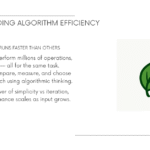Welcome back to our journey through algorithm analysis! In our previous discussion, we explored why counting operations is more reliable than measuring execution time. Today, we’re going to dive deep into Big O notation – the formal way computer scientists describe and compare algorithm efficiency.
What is Big O Notation?
Big O notation is essentially formalized, systematic counting. It’s a mathematical way to describe how an algorithm’s runtime changes as the input size grows. Think of it as a standardized language that allows programmers worldwide to communicate about algorithm efficiency.
Here’s the key insight: Big O focuses on the relationship between input size and runtime growth, not the exact number of operations or the precise execution time.
The Formal Definition (Don’t Panic!)
Mathematically, we say an algorithm is O(f(size)) if the number of operations is eventually less than some constant multiplied by f(size) as the input size increases.
That sounds intimidating, but it’s actually quite simple. It’s just saying: “As your input gets bigger, your algorithm won’t perform worse than this pattern.”
Understanding Different Big O Categories
Let’s explore the most common Big O classifications with practical examples:
1. O(1) – Constant Time
Constant time means the algorithm takes the same amount of time regardless of input size.
def get_first_element(data_list):
"""Returns the first element of a list"""
if len(data_list) > 0:
return data_list[0] # Array access is O(1)
return None
def calculate_circle_area(radius):
"""Calculates the area of a circle"""
pi = 3.14159
area = pi * radius * radius # 3 operations total
return area
Analysis:
get_first_element: Whether the list has 10 elements or 10 million, accessing the first element takes the same timecalculate_circle_area: Always performs exactly 3 operations regardless of the radius value
Real-world analogy: Getting a book from a specific shelf location in a library. Whether the library has 1,000 or 1,000,000 books, if you know the exact location, it takes the same time to retrieve it.
2. O(size) – Linear Time
Linear time means the runtime grows proportionally with the input size.
def find_maximum(numbers):
"""Finds the maximum number in a list"""
if not numbers:
return None
max_value = numbers[0] # 1 operation
for num in numbers[1:]: # Loop runs (size-1) times
if num > max_value: # 1 comparison per iteration
max_value = num # 1 assignment (when condition is true)
return max_value
def print_all_elements(items):
"""Prints each element in a list"""
for item in items: # Loop runs 'size' times
print(item) # 1 operation per iteration
Analysis:
- If the input has 100 elements, we perform roughly 100 operations
- If the input has 1,000 elements, we perform roughly 1,000 operations
- The growth is linear – double the input, double the operations
Real-world analogy: Reading every book in a library to find your favorite. The more books there are, the longer it takes, in direct proportion.
3. O(size²) – Quadratic Time
Quadratic time means the runtime grows with the square of the input size.
def find_duplicate_pairs(numbers):
"""Finds all pairs of duplicate numbers"""
duplicates = []
length = len(numbers)
for i in range(length): # Outer loop: runs 'length' times
for j in range(i + 1, length): # Inner loop: runs (length-i-1) times
if numbers[i] == numbers[j]: # 1 comparison per inner iteration
duplicates.append((numbers[i], numbers[j]))
return duplicates
def print_multiplication_table(size):
"""Prints a multiplication table"""
for row in range(1, size + 1): # Outer loop: runs 'size' times
for col in range(1, size + 1): # Inner loop: runs 'size' times
product = row * col # 1 multiplication per iteration
print(f"{row} × {col} = {product}")
Analysis:
- For input size 10: roughly 10 × 10 = 100 operations
- For input size 100: roughly 100 × 100 = 10,000 operations
- For input size 1,000: roughly 1,000 × 1,000 = 1,000,000 operations
Real-world analogy: Comparing every person in a room with every other person. In a room of 10 people, you need 45 comparisons. In a room of 100 people, you need 4,950 comparisons!
Big O Focuses on Worst-Case Scenarios
An important concept: Big O describes the upper bound or worst-case scenario. We’re asking: “What’s the maximum amount of work this algorithm might have to do?”
def find_target_value(data_list, target):
"""Searches for a target value in a list"""
for i, value in enumerate(data_list):
if value == target:
return i # Found it! Could happen immediately
return -1 # Not found
# Best case: target is the first element - O(1)
# Worst case: target is the last element or not present - O(size)
# Big O classification: O(size)
Even though the best case is O(1), we classify this as O(size) because that’s the worst that can happen.
The Art of Simplification
Now comes the crucial part: how do we simplify Big O expressions? Remember, we care about the big picture trends, not precise counts.
Rule 1: Constants Don’t Matter
# Example 1: Multiple constant operations
def process_data(data_list):
# Each of these is O(1)
first = data_list[0] # 1 operation
second = data_list[1] # 1 operation
third = data_list[2] # 1 operation
result = first + second + third # 1 operation
return result * 2 # 1 operation
# Total: 5 operations
# Big O: O(5) → simplifies to O(1)
Why? Whether it’s 5 operations or 500 operations, if it’s constant, the trend is the same – a flat line.
# Example 2: Linear with constants
def double_and_print(numbers):
# First pass: O(length)
for num in numbers:
doubled = num * 2
print(f"Original: {num}, Doubled: {doubled}")
# Second pass: O(length)
for num in numbers:
print(f"Processing: {num}")
# Third pass: O(length)
for num in numbers:
print(f"Final: {num}")
# Total: 3 × length operations
# Big O: O(3 × length) → simplifies to O(length)
Rule 2: Smaller Terms Don’t Matter
def complex_operation(data_list):
size = len(data_list)
# O(size²) operations
for i in range(size):
for j in range(size):
print(f"Processing {i}, {j}")
# O(size) operations
for item in data_list:
print(f"Item: {item}")
# O(1) operations
print("Done!")
# Total: O(size²) + O(size) + O(1)
# Simplified: O(size²)
Why? As input grows large, the size² term dominates completely:
- size = 100: 100² + 100 + 1 = 10,101 (size² is 99% of the work)
- size = 1000: 1000² + 1000 + 1 = 1,001,001 (size² is 99.9% of the work)
Practical Examples of Simplification
Let’s analyze some real algorithms:
Example 1: Conditional Loops
def print_at_least_five(max_count):
"""Prints numbers 1 to max_count, but always prints at least 5"""
limit = max(max_count, 5) # O(1)
for i in range(1, limit + 1): # O(max(max_count, 5))
print(i) # O(1) per iteration
Analysis:
- When max_count ≤ 5: Always prints exactly 5 numbers
- When max_count > 5: Prints max_count numbers
- As max_count approaches infinity, the 5 becomes irrelevant
- Big O: O(max_count)
Example 2: Capped Loops
def print_at_most_ten(max_count):
"""Prints numbers 1 to max_count, but never more than 10"""
limit = min(max_count, 10) # O(1)
for i in range(1, limit + 1): # O(min(max_count, 10))
print(i) # O(1) per iteration
Analysis:
- When max_count ≤ 10: Prints max_count numbers
- When max_count > 10: Always prints exactly 10 numbers
- As max_count approaches infinity, it’s always capped at 10
- Big O: O(1) (constant time)
Rules of Thumb for Analysis
Here are some practical guidelines for analyzing algorithm complexity:
Basic Operations Are Usually O(1)
# All of these are typically O(1)
x = 5 # Variable assignment
y = x + 10 # Arithmetic operation
z = numbers[0] # Array access by index
person = {"name": "Alice"} # Object property access
result = person["name"] # Dictionary key lookup
Loops Multiply Complexity
# Single loop: O(size)
for i in range(size):
print(i) # O(1) operation
# Nested loops: O(size × size) = O(size²)
for i in range(size): # O(size)
for j in range(size): # O(size) for each i
print(i, j) # O(1) operation
# Triple nested: O(size³)
for i in range(size): # O(size)
for j in range(size): # O(size) for each i
for k in range(size): # O(size) for each i,j combination
print(i, j, k) # O(1) operation
Sequential Operations Add Up
def multiple_operations(data_list):
size = len(data_list)
# O(size) operation
for item in data_list:
print(f"First pass: {item}")
# O(size²) operation
for i in range(size):
for j in range(size):
print(f"Pair: {i}, {j}")
# O(size) operation
for item in data_list:
print(f"Final pass: {item}")
# Total: O(size) + O(size²) + O(size) = O(size²)
Visual Understanding: The Growth Chart
Imagine plotting these functions on a graph where the x-axis is input size and y-axis is operations:
| Input Size | O(1) | O(log size) | O(size) | O(size²) | O(2^size) |
|---|---|---|---|---|---|
| 1 | 1 | 1 | 1 | 1 | 2 |
| 10 | 1 | 3 | 10 | 100 | 1,024 |
| 100 | 1 | 7 | 100 | 10,000 | 10³⁰ |
| 1,000 | 1 | 10 | 1,000 | 1,000,000 | 10³⁰⁰ |
Key insights:
- O(1): Flat line – always the same
- O(size): Diagonal line – steady growth
- O(size²): Curved line – accelerating growth
- O(2^size): Exponential curve – explosive growth
Why This Matters in Real Applications
Understanding Big O helps you make informed decisions:
Database Queries
# O(1) - Direct lookup
user = database.get_user_by_id(12345)
# O(size) - Scan all records
users = database.get_all_users_with_email_domain("gmail.com")
# O(size²) - Nested loop join (avoid!)
for user in all_users:
for order in all_orders:
if user.id == order.user_id:
print(f"{user.name} ordered {order.product}")
Web Applications
# O(1) - Good for any size
def get_user_profile(user_id):
return user_cache[user_id]
# O(size) - Acceptable for reasonable sizes
def search_products(query):
return [p for p in products if query in p.name]
# O(size²) - Problematic for large datasets
def find_similar_users(target_user):
similar = []
for user1 in all_users:
for user2 in all_users:
if calculate_similarity(user1, user2) > 0.8:
similar.append((user1, user2))
return similar
Common Misconceptions
“O(2n) is different from O(n)”
False! Both represent linear growth. The constant factor (2) is ignored in Big O analysis.
“O(n + m) should be simplified to O(n)”
False! If n and m are independent variables of potentially different sizes, you cannot simplify this further.
“Big O tells us the exact runtime”
False! Big O describes the growth pattern, not the exact time. An O(n²) algorithm might actually be faster than an O(n) algorithm for small inputs.
Practical Tips for Algorithm Analysis
- Identify the input size: What grows as your problem gets bigger?
- Find the loops: Most complexity comes from iteration
- Look for nested structures: They often indicate polynomial growth
- Focus on the worst case: What’s the most work the algorithm might do?
- Ignore constants and small terms: Think about the big picture
Summary
Big O notation is your tool for understanding algorithm scalability. It helps you:
- Compare algorithms objectively across different computers and environments
- Predict performance as your data grows
- Make informed decisions about which algorithms to use
- Communicate clearly with other developers about performance expectations
Remember these key simplification rules:
- Constants don’t matter: O(5n) → O(n)
- Smaller terms don’t matter: O(n² + n) → O(n²)
- Focus on worst-case scenarios
- Think about growth patterns, not exact counts
The next time you write code, ask yourself: “How will this perform when I have 10 times more data? 100 times more? 1,000 times more?” Big O notation gives you the vocabulary to answer these questions precisely.
In our next post, we’ll explore more advanced Big O concepts including logarithmic time complexity and space complexity analysis. Until then, practice identifying Big O patterns in your own code – you’ll be amazed at how this changes your perspective on algorithm design!
Thanks.
-Grass Coder





